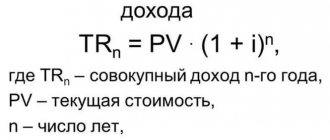Simplified balance sheet and “simplified” balance sheet: what is the difference
The obligation of companies using the simplified tax system to keep records and draw up a balance sheet today is mandatory for almost all “simplified” companies, with rare exceptions (Article 6 of the Law “On Accounting” dated December 6, 2011 No. 402-FZ).
In most cases, “simplified” companies fall under the criteria of a small enterprise, so they can choose which form to draw up the balance sheet - general or simplified (Clause 4, Article 6 of Law No. 402-FZ).
Consequently, a simplified balance sheet and a “simplified” balance sheet are not the same thing, since this report can be drawn up not only in a simplified form, but also in a generally established form.
Read about what characterizes the balance sheet of the generally established form in the material “Balance Sheet (Assets and Liabilities, Sections, Types).”
NOTE! Organizations subject to mandatory audit and a number of other companies listed in clause 5 of Art. 6 of Law No. 402-FZ.
In order for the compiled balance sheet to be reliable and useful to stakeholders, the company must properly organize the accounting process.
For more information about accounting options, accounting policies and chart of accounts for companies using the simplified tax system, read the article “Procedure for maintaining accounting records under the simplified tax system .
The traditional form of the balance sheet is familiar to everyone, so let’s take a closer look at the simplified form of the report.
Simplified form of balance sheet (STS)
A simplified form of the balance sheet is given in Appendix 5 to Order No. 66n of the Ministry of Finance of Russia dated July 2, 2010.
ATTENTION! From 2021, financial statements, incl. simplified, submitted exclusively electronically. Paper forms will no longer be accepted. Read more about changes to the rules for presenting financial statements here. We also remind you that in 2021 the reporting forms have been updated.
In all reporting forms (including balance sheet and Form 2):
- the unit of measurement has become thousands of rubles, it is impossible to fill out reports in millions;
- OKVED has been replaced by OKVED2.
In some forms it is replaced by OKUD.
In the traditional balance sheet, a line is introduced to indicate whether the statements are subject to mandatory audit or not. If yes, you need to talk about the auditor.
New machine-readable forms for full and simplified reporting can be downloaded here.
As for the actual differences between the simplified form of the balance sheet and the usual (traditional) one, the simplified one contains fewer lines in assets and liabilities. But this does not mean that something may not be reflected in the balance sheet or may not be included in full.
It is not always necessary to fill out all lines of the simplified balance sheet. This is possible when the company does not have any assets or liabilities at the reporting date. For example, a company uses only leased property and does not create fixed assets itself. In this case, the corresponding balance line is not filled in.
A sample of filling out a simplified balance sheet for 2020 was prepared by ConsultantPlus experts. Get trial access to the K+ system and study the material for free:
What do they include
For detailed information on the state of other current assets, it is assumed that there is a specially designated line 12605 “Deferred expenses”.
This line reflects income from the sale of property, the right to ownership of which has not yet been registered in the name of the buyer. To clarify the situation, an accompanying note or a note in the form of an additional line with a transcript is allowed as an attachment.
Also, line 12605 takes into account the value added tax, which was accrued on the amount of revenue received, but cannot be temporarily taken into account due to the following circumstances regulated in PBU 9/99. Conditions for revenue recognition that must be met simultaneously:
- The right to receive revenue for an organization is legally secured and has a legal basis, i.e. it arose when concluding the relevant agreement or in another way.
- The amount of money received is determinable.
- When there is a guarantee that from specific actions, the enterprise will receive an increase in economic benefits. For example, when a firm has received payment for an asset or its receipt is certain.
- Ownership of certain products has been transferred from the organization to the buyer, customer, and also if the service has been provided in full and accepted.
- The expenses that the company has made or plans to make have a cost determination.
If at least one condition is not met, then the cash and other assets that were transferred to the company will not be taken into account in the revenue column, but will be taken into account in the balance sheet in the accounts receivable group.
However, there are exceptions:
- Lease or provision for temporary operation of any asset owned by the company.
- Providing intellectual property products – registered patents – for remuneration for temporary use. They can be for inventions, samples of industrial equipment and other types.
- Taking part in the authorized capital of other enterprises.
To recognize the revenue of such organizations, it is necessary to simultaneously fulfill only the first three items from the list.
- The amount of damage caused due to property damage or shortages, the culprit of which has not yet been identified or a decision has not been made to write them off as expenses for the production process or sales expenses.
- VAT and excise taxes refundable in the near future.
- The price determined by the contract, which has been calculated but not yet issued.
- The amount of shares that were purchased from other companies for further resale.
We fill out the balance sheet asset in a simplified form
You must enter data in the following 5 lines:
- "Tangible non-current assets."
ATTENTION! From 2021, reserves must be maintained in accordance with FSBU 5/2019 “Reserves”. PBU 5/01 will no longer be in force. How to switch to inventory accounting according to FSBU 5/2019, read here.
This shows the residual value of assets (balance of accounts 01 and 03 minus balance of account 02) and adds expenses for construction in progress (account 08).
- “Intangible, financial and other non-current assets.”
The residual value of intangible assets is reflected (together with “work in progress” and R&D expenses associated with these assets), deposit balances (account 55), long-term financial investments (account 58), as well as long-term debts reflected in settlement accounts (60, 62 , 68, 69, 70, 71, 73, 75 and 76).
- When filling out the “Inventories” line, you will need information about the balances of materials, goods, finished products (accounts 10, 41, 44, 45), costs in work in progress (account 20), including the balance on account 97 (for expenses with a write-off period of less than 12 months).
- Information about cash and cash equivalents, which must be reflected in line 4, is collected from all “cash” accounts (50, 51, 52, 55, 57) excluding subaccount 55 “Deposit accounts”.
- The line “Financial and other current assets” contains information about short-term financial investments (account 58), the amount of short-term debts reflected in the settlement accounts, as well as all other assets of the company that do not find a place in this section of the report.
NOTE! Financial investments, accounts receivable and inventories in the balance sheet assets must be shown without taking into account reserved amounts (account balances 59, 63, 14), that is, in a net valuation (PBU 4/99).
Analysis of the structure and dynamics of property and sources of financing
An assessment of the structure and dynamics of property (assets) gives an idea of the ratio of fixed and working capital, the share of inventories in current assets, as well as changes in their value for the analyzed period.
The structure and dynamics of sources of financing (liabilities) shows the shares of own, borrowed and borrowed funds, as well as their changes over the analyzed period, which is a well-known technique for analyzing financial statements.
However, this information is not particularly important when assessing the activities of a small enterprise. The authorized capital of a small enterprise is usually small
They carry out their current activities mainly from their own funds and accounts payable. Trade and purchasing activities and settlement operations, as a rule, are carried out on an advance payment basis or through obtaining a commercial (commodity) loan. Therefore, a very important factor is maintaining liquidity and solvency, which characterize the ability of an enterprise to timely and fully make payments on current obligations.
Simplified balance sheet liability
This section of the report, consisting of 6 lines, is filled out in the following order:
- "Capital and reserves".
All credit balances on accounts 80 (minus the debit balance of account 81), 82, 83 and 84 are entered here. If a loss is reflected on account 84 (i.e. there is a debit balance), then it is taken into account in the same way as the data reflected on account 81. If the overall result is negative, it will be shown in parentheses.
- "Long-term borrowed funds."
The figure in this line should reflect the balance of the company's debt on long-term loans and borrowings (account 67). In this case, accrued interest, the maturity of which as of the reporting date is less than 12 months, is excluded.
- "Other long-term liabilities."
Filled out for the amount of long-term liabilities listed in the loan balances in accounts 60, 62, 68, 69, 70, 71, 73, 75 and 76.
- "Short-term borrowed funds."
This line includes the balance of account 66, as well as the balance of accrued interest that was not taken into account when filling out information on long-term loans and borrowings.
- "Accounts payable".
This shows the sum of credit balances in accounts 60, 62, 68, 69, 70, 71, 73, 75 and 76 for all short-term liabilities.
- "Other current liabilities."
A line that may be missing or not filled in if all the necessary information about obligations is reflected in the 5 previous lines.
NOTE! After filling out the liability and asset lines of the balance sheet, you need to compare the results obtained. The sum of all asset lines must be equal to the result of adding the liability lines.
For information on how a balance sheet drawn up in a generally established form is checked, read the article “Procedure for drawing up a balance sheet (example).”
For step-by-step instructions on filling out each line of the simplified balance sheet, see the guide from ConsultantPlus. If you do not have access to the K+ system, get a trial online access for free.
Calculation of coefficients characterizing financial stability
To assess financial stability, the following relative indicators can be used to characterize the state of working capital, the structure of funding sources, and the financial independence of the enterprise:
where, SOS - own working capital; OA - current assets; Z - reserves; KR - capital and reserves; SK - equity capital; VB - balance sheet currency (total cost of funding sources); DZS - long-term borrowed funds; KZS - short-term borrowed funds
Let us summarize the procedure for calculating the considered coefficients using the corresponding balance sheet line codes:
Kss = (line 1300-(line 1150+line 1110)) / (line 1210+line 1250+line 1230) Kmz = (line 1300-(line 1150+line 1110)) / line .1210 Kmsk = (p.1300-(p.1150+p.1110)) / p.1300 Kdz = p.1400 / p.1300 Ka = p.1300 / p.1700 Kfa = (p.1410+p. 1510) / line 1300 Cfu = (line 1300+line 1410) / line 1700
When using the indicated indicators of financial stability in analytical practice, it is necessary to keep in mind that they reflect the financial condition as of a date that has already passed. Therefore, it is advisable to consider them in dynamics over several reporting periods, which will indicate a certain consistency in the activities of the enterprise. In addition, the recommended values of these coefficients are conditional and depend on the characteristics of financial and economic activities, on internal and external economic factors.
To whom and when should the balance be submitted?
The simplifier filled out the balance. What's next? It does not matter in what form this balance sheet is drawn up (traditional or simplified). A company using the simplified tax system is obliged to submit a report (as part of other mandatory accounting reports) to the interested authorities.
Since 2021, the only such government agency is the Federal Tax Service. Most companies no longer need to submit accounting reports to statistics. The due date remains the same - March 31 of the year after the reporting year. This period is determined by both tax (subclause 5, clause 1, article 23 of the Tax Code of the Russian Federation) and accounting (clause 2, article 18 of law No. 402-FZ) legislation.
If you are just starting a business and registered after September 30 of the reporting year, you only need to prepare and submit a balance sheet for the first time at the end of the next year. For example, a company was registered on October 10, 2020 - for the first time it is required to report for the period from October 10, 2020 to December 31, 2021 (Clause 3, Article 15 of Law No. 402-FZ).
For presentation to management, owners or counterparties, the balance sheet can be drawn up at any other frequency (clause 4, article 13 of law No. 402-FZ). In this case, the state (represented by tax authorities and statistics) is not required to submit reports.
NOTE! If your company does not send the balance to the tax authorities or does so late, the fine will be 200 rubles. (clause 1 of article 126 of the Tax Code of the Russian Federation). Administrative punishment under Art. 15.6 Code of Administrative Offenses of the Russian Federation. Account blocking does not apply in this case.
In addition, significant fines have been established for failure to approve financial statements.
Line 1230 “Accounts receivable”
Line 1230 about accounts receivable. The following debts are included in accounts receivable:
- buyers for goods supplied to them, services provided, work performed;
- suppliers for advances transferred to them;
- accountable persons for the money given to them;
- budget and extra-budgetary funds for overpayments of taxes or contributions, etc.
Accordingly, in line 1230 enter the debit balance of accounts for accounting settlements: 60 “Settlements with suppliers and contractors”, 62 “Settlements with buyers and customers”, 68 “Settlements for taxes and contributions”, 69 “Settlements for social insurance and security”, etc. .d.
Results
In order to correctly draw up a balance sheet, a company using the simplified tax system must competently organize the accounting process, develop accounting policies and a working chart of accounts. Then you need to decide on the form of the balance sheet. A simplifier can choose between traditional and simplified.
A simplified report is easier to fill out, but the information presented cannot be shortened. The balance sheet must reliably reflect the value of the property and the amount of the company's liabilities as of the reporting date. The finished balance is sent to tax authorities, statistical authorities and all interested parties.
Sources:
- Federal Law of December 6, 2011 No. 402-FZ
- Tax Code of the Russian Federation
- Order of the Ministry of Finance of Russia dated July 2, 2010 No. 66n
You can find more complete information on the topic in ConsultantPlus. Free trial access to the system for 2 days.








